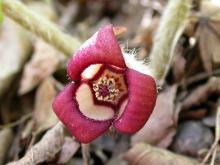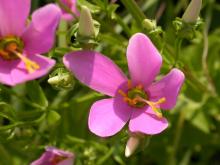Wildflowers, Grasses and Other Nonwoody Plants
Media

Species Types
Scientific Name
Asarum canadense
Description
In spring, wildflower lovers locate wild ginger by looking for its unique, hairy, heart-shaped leaves, then by stooping to view the small, three-parted brown flowers that form between the leaf bases, close to the ground.
Media

Species Types
Scientific Name
Sabatia angularis
Description
Rose-pink, or rose gentian, is a delicately scented native wildflower with floral clusters resembling candelabras. It has square stems and clasping leaves. It is common in open Ozark woods and fields and blooms June–September.
Media

Species Types
Scientific Name
Dioscorea oppositifolia (sometimes called D. batatas)
Description
Similar to kudzu, Chinese yam is an aggressive vine that overtakes nearly everything within reach that stands still long enough! Learn more about this invasive plant — and please don’t plant it!
Media

Species Types
Scientific Name
Asclepias incarnata
Description
Swamp milkweed has pink flower clusters at the tips of its tall stalks. The leaves are opposite, narrow, and up to 6 inches long. It grows in moist bottomland soils.
Media

Species Types
Scientific Name
Asclepias purpurascens
Description
The flowers of purple milkweed are pale purple to reddish purple to dark purple, with greenish or red tints. The scientific name means “becoming purple”: The flowers start off rather pale and become more intensely purplish as they mature.
Media

Species Types
Scientific Name
Saponaria officinalis
Description
Soapwort is a tall, showy wildflower that has chemicals in its sap that lather up like soap. Native to Eurasia, it has been introduced worldwide and is a common roadside wildflower.
Media

Species Types
Scientific Name
Dianthus armeria
Description
Deptford pink has straight, strong, narrow stems that bear small clusters of pink flowers with white dots. Common statewide in sunny, open locations such as pastures and roadsides.
Media

Species Types
Scientific Name
Physostegia virginiana
Description
False dragonhead is called "obedient plant" because when you push one of the flowers sideways, it "obediently" stays in place for a while.
Media

Species Types
Scientific Name
Clematis fremontii
Description
The only non-climbing clematis in the state, Fremont’s leather flower is a shrubby perennial with bell-shaped flowers. It grows on open glades in the eastern part of Missouri and in southwestern Missouri’s Ozark County.
Media

Species Types
Scientific Name
Apocynum cannabinum
Description
Indian hemp is a shrubby, upright perennial with opposite branches and milky sap. This native plant can be a troublesome weed in crop fields and gardens, but Native Americans used its tough, fibrous stems for rope-making.
See Also
About Wildflowers, Grasses and Other Nonwoody Plants in Missouri
A very simple way of thinking about the green world is to divide the vascular plants into two groups: woody and nonwoody (or herbaceous). But this is an artificial division; many plant families include some species that are woody and some that are not. The diversity of nonwoody vascular plants is staggering! Think of all the ferns, grasses, sedges, lilies, peas, sunflowers, nightshades, milkweeds, mustards, mints, and mallows — weeds and wildflowers — and many more!





















